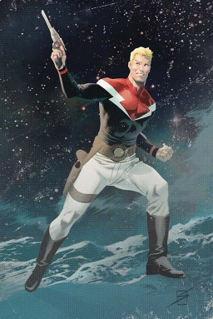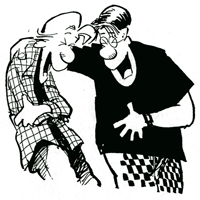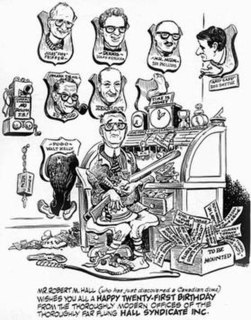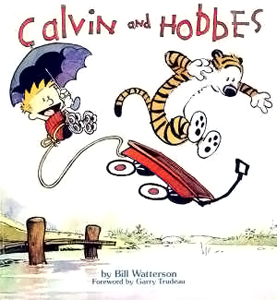
William Boyd Watterson II is an American former cartoonist and the author of the comic strip Calvin and Hobbes, which was syndicated from 1985 to 1995. Watterson stopped drawing Calvin and Hobbes at the end of 1995 with a short statement to newspaper editors and his readers that he felt he had achieved all he could in the medium. Watterson is known for his negative views on licensing and comic syndication, his efforts to expand and elevate the newspaper comic as an art-form, and his move back into private life after he stopped drawing Calvin and Hobbes. Watterson was born in Washington, D.C. and grew up in Chagrin Falls, Ohio. The suburban Midwestern United States setting of Ohio was part of the inspiration for Calvin and Hobbes.

Flash Gordon is the hero of a space opera adventure comic strip created by and originally drawn by Alex Raymond. First published January 7, 1934, the strip was inspired by, and created to compete with, the already established Buck Rogers adventure strip.

Ruben Bolling is a pseudonym for Ken Fisher, a cartoonist, the author of Tom the Dancing Bug. His pieces demonstrate concern about the power of large corporations and satirize the way government has been corrupted by money. Particularly since 2001, Bolling's work often concerns war. Many of his strips admit no political interpretation, instead featuring absurdist humor or parodying comic strip conventions. Bolling's lampoons of celebrity culture, such as in the parodic series of comic strips labeled "Funny, Funny, Celebs", can be scathing.

Stephan Thomas Pastis is an American cartoonist and the creator of the comic strip Pearls Before Swine. He also writes children's chapter books, commencing with the release of Timmy Failure: Mistakes Were Made all the way through the 7th book, It's the End When I Say It's the End., which debuted at #4 on The New York Times Best Seller list for Children's Middle Grade Books.

Zits is a comic strip written by cartoonist Jerry Scott and illustrated by Jim Borgman about the life of Jeremy Duncan, a 16-year-old high school sophomore. The comic debuted in July 1997 in over 200 newspapers and has since become popular worldwide and received multiple awards. As of 2010, it continues to be syndicated by King Features and is now included in "more than 1,700 newspapers worldwide in 45 countries and is translated into 15 different languages."

Rose Is Rose is a syndicated comic strip, written by Pat Brady since its launch on April 16, 1984, and drawn since March 2004 by Don Wimmer. The strip revolves around Rose and Jimbo Gumbo, their son Pasquale, and the family cat Peekaboo. Rose and Jimbo are deeply in love with each other, sometimes exchanging love notes or kissing under the stars, and doting fondly on Pasquale.

Dana Claire Simpson is an American cartoonist, best known as the creator of the syndicated comic strip Phoebe and Her Unicorn, as well as the long-running web comic Ozy and Millie. Other works created by Simpson include the political commentary cartoon I Drew This and the alternate reality drama comic Raine Dog.

Pep Comics is the name of an American comic book anthology series published by the Archie Comics predecessor MLJ Magazines Inc. during the 1930s and 1940s period known as the Golden Age of Comic Books. The title continued under the Archie Comics imprint for a total of 411 issues until March 1987.
The Duplex is a comic strip by Glenn McCoy and now his brother Gary McCoy, syndicated by Universal Press Syndicate/Universal Uclick/Andrews McMeel Syndication since 1993.
Andrews McMeel Publishing, LLC is a company that publishes books, calendars, and related toys. It is a part of Andrews McMeel Universal.

Publishers-Hall Syndicate was a newspaper syndicate founded by Robert M. Hall in 1944. Hall served as the company's president and general manager. Over the course of its operations, the company was known as, sequentially, the Hall Syndicate (1944–1946), the New York Post Syndicate (1946–1949), the Post-Hall Syndicate (1949–1955), the Hall Syndicate (1955–1967), and Publishers-Hall Syndicate (1967–1975). The syndicate was acquired by Field Enterprises in 1967, and merged into Field Newspaper Syndicate in 1975. Some of the more notable strips syndicated by the company include Pogo, Dennis the Menace, Funky Winkerbean, Mark Trail, The Strange World of Mr. Mum, and Momma, as well as the cartoons of Jules Feiffer.
Trajectories was a 1980s tabloid magazine published in Austin, Texas by Richard Shannon and Susan Sneller. It featured news and articles on fantasy, science, science fantasy, science fiction, and science fiction philosophy. It contained reviews of books, poetry, short stories, music and performances. Articles and stories were contributed by Lewis Shiner2, John Shirley, Bruce Boston, Uncle River, Winter Damon and others. A total of six issues appeared irregularly over a six-year span.
The New Adventures of Queen Victoria is a daily webcomic created by Pab Sungenis. It uses the photo-manipulation technique popularized by Adobe Photoshop and other image editing programs to insert actual photographs and paintings of the characters into situations, instead of more conventional methods. It is syndicated online by GoComics, a division of Andrews McMeel Universal, and has been collected into six trade paperback editions.

Hector Cantú is an American writer, editor, and newspaper comic strip creator, best known for the Latino-American strip Baldo. As of 2008, he lives in Dallas, Texas.
Betty is a Canadian comic strip written by Gary Delainey and drawn by Gerry Rasmussen. The comic was originally distributed by United Features Syndicate, and is now distributed via Andrews McMeel Syndication
Uclick LLC was an American corporation selling "digital entertainment content" for the desktop, the web and mobile phones. Uclick operated several consumer websites, including the comic strip and editorial cartoon site GoComics and the puzzle and casual game sites ThePuzzleSociety.com and UclickGames.com.
The Argyle Sweater is an American daily comic strip written by Scott Hilburn, a native of Garland, Texas. The strip has been syndicated by Universal Press Syndicate since April 2008.
Peach is a tree and its edible fruit.


















